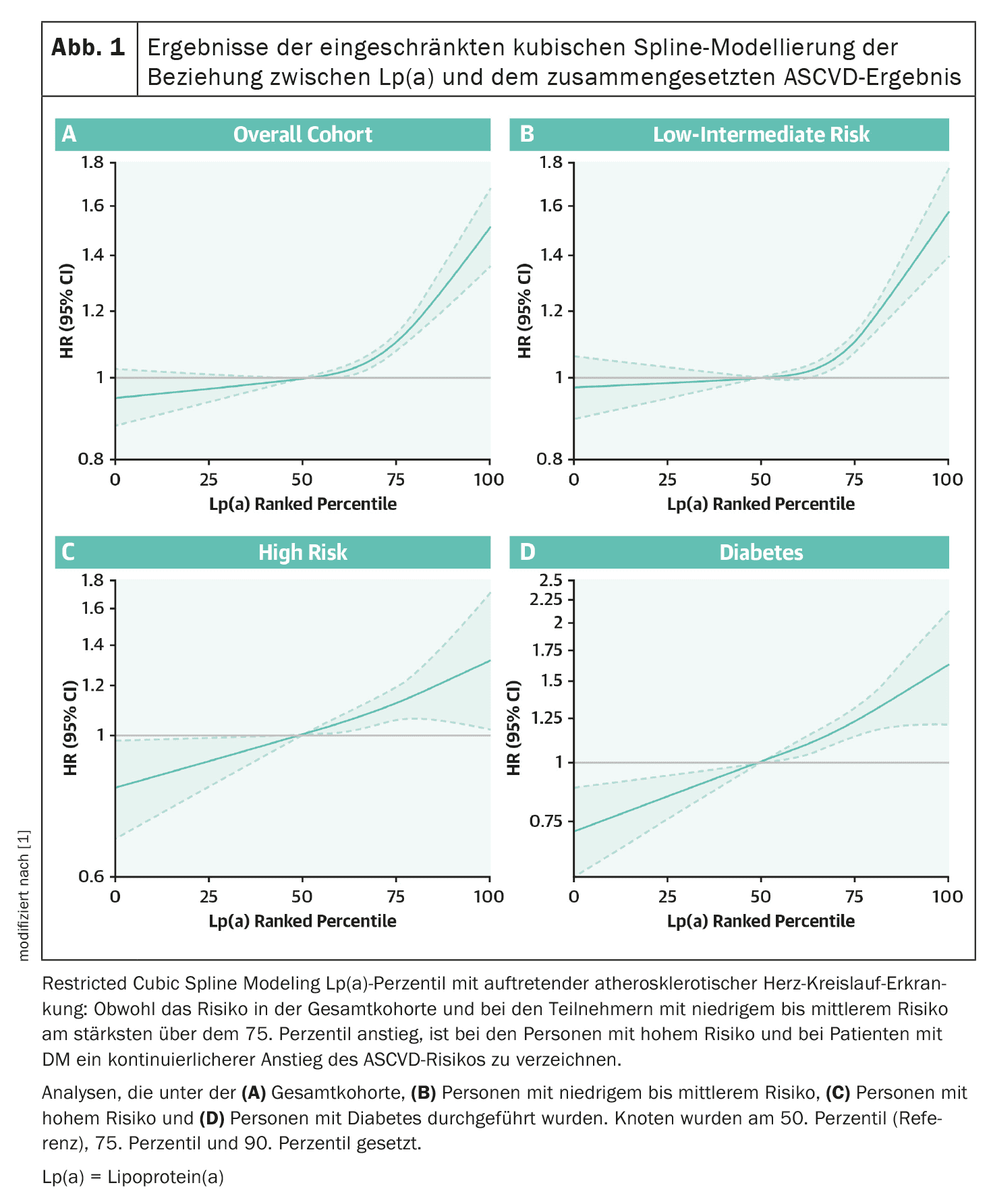Numerous studies have shown that elevated Lp(a) levels are associated with the risk of a number of atherosclerotic cardiovascular diseases (ASCVD), including myocardial infarction (MI), stroke and peripheral arterial disease. However, it is not yet known exactly how Lp(a) can predict the long-term risk of ASCVD events in primary prevention cohorts at increased risk of ASCVD (including those with diabetes).
Lipoprotein(a) [Lp(a)] is a causal genetic risk factor for atherosclerotic cardiovascular disease (ASCVD). Epidemiological studies and meta-analyses, Mendelian randomization studies and finally genome-wide association studies have shown that Lp(a) levels are linearly related to ASCVD risk. Although the ongoing cardiovascular outcome studies targeting Lp(a) have focused on higher-risk groups with pre-existing ASCVD, information on the value of Lp(a) as a predictor of cardiovascular risk in individuals without ASCVD may be useful for the development of future clinical trials in such groups. Studies evaluating the role of Lp(a) in predicting risk in patients with diabetes mellitus (DM) are also inconsistent. Dr. Nathan D. Wong of the Division of Cardiology, University of California, USA, and colleagues conducted the largest and most ethnically diverse cohort analysis of Lp(a) in the US for ASCVD events in primary prevention groups, with a significant proportion of female and black participants [1].
The study included data on Lp(a) and ASCVD outcomes from five prospective studies in the USA. Lp(a) values were classified based on cohort-specific percentiles. Multivariable Cox regression related Lp(a) to composite incident ASCVD by risk group and diabetes status. A total of 27756 individuals without prior ASCVD between the ages of 20 and 79 years were selected for the study, including 55.0% women, 35.6% black participants, and 7.6% diabetics, with a mean follow-up of 21.1 years.
Higher Lp(a) levels consistently associated with increased risk of ASCVD events
Compared with Lp(a) levels <50th percentile, Lp(a) levels in the 50th to <75th, 75th to <90th, and ≥90th percentiles had adjusted HRs of 1.06 (95% CI 0.99-1.14), 1.18 (95% CI 1.09-1.28), and 1.46 (95% CI 1.33-1.59), respectively, for ASCVD events. Elevated Lp(a) levels predicted the occurrence of ASCVD events similarly according to risk group, sex and race or ethnicity, but more strongly in patients with and without diabetes (interaction p=0.0056), with HRs for Lp(a) level values ≥90th percentile of 1.92 (95% CI 1.50-2.45) and 1.41 (95% CI 1.28-1.55), respectively. In addition, Lp(a) individually predicted myocardial infarctions, revascularizing interventions, strokes and deaths from coronary heart disease, but not all-cause mortality.
Lp(a) as a strong predictor of ASCVD risk in people with DM
According to Dr. Wong and colleagues, their analysis shows that higher Lp(a) levels were associated with an increased long-term risk of ASCVD events over a follow-up period of more than 20 years, independent of other factors. However, the correlations were stronger in people with and without diabetes mellitus (DM), but similar in low- to intermediate-risk and high-risk primary prevention groups, in women and men, by race or ethnicity, and across the range of LDL-C levels. In addition, an increased risk of ASCVD events was also demonstrated at higher Lp(a) levels for the ASCVD components of MI, stroke, revascularization, and coronary heart disease (CHD) death.
As the authors note, the outcomes are largely consistent with results from the UK Biobank [2]. They showed a similarity in the predictive strength of Lp(a) to ASCVD events by race or ethnicity (white, South Asian and black participants) and in men and women in relation to emerging risk factors.
Lp(a) is a particularly strong predictor of ASCVD risk in people with DM, with the risk of ASCVD events being almost twice as high in those with Lp(a) levels at or above the 90th percentile, the authors emphasized (Fig. 1). Although the BiomarCaRE (Biomarkers for Cardiovascular Risk Assessment in Europe) project [3] with 56 804 participants from 7 prospective cohorts across Europe showed that Lp(a) levels were more predictive of major CHD and CVD incidence and all-cause mortality in people with DM than in people without DM with numerically higher HRs, heterogeneity tests were only significant for all-cause mortality. However, in the UK Biobank, Lp(a) (per 50 nmol/l) was a weaker predictor of ASCVD in people with DM (HR 1.07; 95% CI 1.05-1.10) compared with people without DM (HR 1.11; 95% CI 1.10-1.12; p=0.01). In secondary prevention studies, a significant increase in risk was found at Lp(a) levels of 50 mg/dl or higher in a large cohort of patients with stable ASCVD. Lp(a) has also been shown to be a significant predictor of ASCVD outcomes (HR 1.1 per 37 nmol/l) in a subgroup with diabetes mellitus from the AIM-HIGH cohort** [4] of people with ASCVD receiving statin therapy. However, a more recent study of 1018 people with recent myocardial infarction found that Lp(a) predicted recurrence of myocardial infarction and death in participants without DM, but not in participants with DM.
** Atherothrombosis Intervention in Metabolic Syndrome with Low HDL/High Triglycerides: Impact on Global Health Outcomes
Although studies have also shown an inverse association between Lp(a) levels and the risk of DM, it is unclear to what extent this is causal or the result of reverse causality or related to concomitant comorbidities, the authors emphasize. A recent meta-analysis of eight observational studies found a 38% higher risk of developing DM in individuals in the lower quintile of Lp(a) (<3 bis 5 mg/dl) im Vergleich zum oberen Quintil von Lp(a) (>27 to 55 mg/dl). According to the authors, their analysis suggests a smaller effect (14% higher risk), even among individuals in the lowest decile of Lp(a) levels (<1 mg/dl). In addition, the researchers point out that for ongoing cardiovascular outcome studies targeting Lp(a), it is important to examine the comparative effect (and whether there is a linear relationship) of lowering Lp(a) on ASCVD events in participants with and without DM, and whether pharmacologic lowering of Lp(a) to very low levels actually leads to an increased incidence of DM. The issue of residual risk associated with elevated Lp(a) despite currently available therapies and well-controlled LDL-C is also important to inform the future development of clinical trials of Lp(a)-lowering drugs. This analysis showed that higher Lp(a) levels in primary prevention consistently predicted future ASCVD events up to an LDL-C of 70 mg/dl (with less consistent results below this level). Most of the available data are from secondary prevention cohorts receiving statin therapy. The use of cholesterol-lowering therapy in these analysis cohorts was low at baseline (<5%). In a meta-analysis of seven large placebo-controlled trials of statin therapy in 29069 patients, Lp(a) was shown to reliably predict ASCVD events, albeit more strongly in patients receiving statin therapy. In the AIM-HIGH study cohort, Lp(a) levels ≥70 mg/dl strongly predicted first and overall recurrent ASCVD events. Finally, in terms of primary prevention, the UK Biobank cohort showed that Lp(a) (per 50 nmol/l increment) predicted ASCVD events in both those taking statins (HR 1.07; 95% CI 1.05-1.08) and those not taking statins (HR 1.11; 95% CI 1.10-1.13), although these effects were heterogeneous (p<0.0001).
Although clinical trials are currently underway to investigate whether additional efficacy in lowering Lp(a) levels can be achieved for secondary prevention beyond existing statin therapy, the results of Wong et al. suggest the potential importance of clinical trials for selected primary prevention groups who are at increased absolute risk of ASCVD events. In addition, the results support the validity of Lp(a) screening for primary prevention, including in people with diabetes mellitus, and lend further relevance to recent recommendations calling for universal Lp(a) screening.
Literature:
- Wong ND, et al: Lipoprotein(a) and Long-Term Cardiovascular Risk in a Multi-Ethnic Pooled Prospective Cohort. Journal of the American College of Cardiology 2024; 83: 1511-1525;
doi: 10.1016/j.jacc.2024.02.031. - Patel AP, et al: Lp(a) (Lipoprotein[a]) Concentrations and Incident Atherosclerotic Cardiovascular Disease: New Insights From a Large National Biobank. Arteriosclerosis, Thrombosis, and Vascular Biology 2020; doi: 10.1161/ATVBAHA.120.315291.
- Waldeyer C, et al: Lipoprotein(a) and the risk of cardiovascular disease in the European population: results from the BiomarCaRE consortium. Eur Heart J 2017; 38(32): 2490-2498;
doi: 10.1093/eurheartj/ehx166. - Guyton JR, et al: Relationship of lipoproteins to cardiovascular events: the AIM-HIGH Trial (Atherothrombosis Intervention in Metabolic Syndrome With Low HDL/High Triglycerides and Impact on Global Health Outcomes). J Am Coll Cardiol 2013; 62(17): 1580-1584;
doi: 10.1016/j.jacc.2013.07.023.
InFo DIABETOLOGY & ENDOCRINOLOGY 2025; 2(1): 28-30










